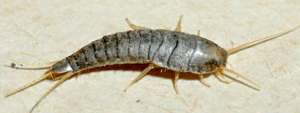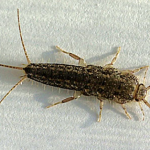Recently I was in full study mode for my Associate Certified Entomologist test which goes beyond just knowing the habitat of a roach or the techniques in yellow jacket extermination. To be an A.C.E. means you were required to know the biological classifications of insects. Kingdom, phylum, class, order, family, genus, species-WHEW- that was a task in and of itself and this was only a small part of the testing. Now since I’m not real high on the ol IQ meter I needed all the help I could get and fortunately for me at least one description of the silverfish was kind of easy to remember. Silverfish are in the order of thysanura but I remembered it as thysanura– sorus-rex. You see silverfish are one of the earliest known insects pre dating even dinosaurs and although they were a little smaller and had simpler features such as eyes, they really haven’t changed much over the millions of years. So while ‘Rocko’ the caveman had to deal with tyrannosaurus rex from time to time, it’s also a fair bet that Mrs.Rocko was on him just as hard to perform pest control in the cave for the other thysanura running around.
Do You Have Silverfish? The chances are 4 to 1
If you live in a home in America the chances are very good that you have silverfish. There are 4 Lepisma, (that’s the genus silverfish are in) that are considered pests and can thrive in our homes. Their diets range from cereals and other foods in pantries to glues and pastes of wall paper and books. During hard times silverfish can go up to one year without food or it may resort to eating leather and even synthetic goods. The Lepismatidae (family that thysanura belong to) are truly hardy and thrive in places most insects don’t tolerate. The attic is a common place to find silverfish and where undisturbed storage can become severely damaged by its eating. The common silverfish needs high humidity of about 75% to thrive and un-vented attics are ideal. Common silverfish are born whitish but as they grow by molting, they take on the trademark silver coloration. It is believed the common silverfish travels about as a stow away in storage or packed boxes and even brought in with insulation for new homes.
that are considered pests and can thrive in our homes. Their diets range from cereals and other foods in pantries to glues and pastes of wall paper and books. During hard times silverfish can go up to one year without food or it may resort to eating leather and even synthetic goods. The Lepismatidae (family that thysanura belong to) are truly hardy and thrive in places most insects don’t tolerate. The attic is a common place to find silverfish and where undisturbed storage can become severely damaged by its eating. The common silverfish needs high humidity of about 75% to thrive and un-vented attics are ideal. Common silverfish are born whitish but as they grow by molting, they take on the trademark silver coloration. It is believed the common silverfish travels about as a stow away in storage or packed boxes and even brought in with insulation for new homes.
 The firebrat is in the family (lepismatidae) thysanura but of the genus thermobia and species of T. domestica. This relative is mostly found outdoors but can easily transition to indoor living. Firebrats are not ‘silver’ rather dark gray with mottled yellow. Firebrats prefer it even hotter than their cousins and seek out places like furnace rooms or bakeries where it gets up to 90 degrees or hotter.
The firebrat is in the family (lepismatidae) thysanura but of the genus thermobia and species of T. domestica. This relative is mostly found outdoors but can easily transition to indoor living. Firebrats are not ‘silver’ rather dark gray with mottled yellow. Firebrats prefer it even hotter than their cousins and seek out places like furnace rooms or bakeries where it gets up to 90 degrees or hotter.
The gray silverfish is in the same class as the others known as insecta but its genus  ctenolepisma and species longicaudata. This silverfish prefers drier locations such as vented attics or crawl spaces. This genus is larger than the others and only has two pairs of styli on the abdomen where the others have 3. The gray silverfish is also uniformally gray in color and sometimes quite dark. The gray silverfish is thought to be more of a paper goods pest.
ctenolepisma and species longicaudata. This silverfish prefers drier locations such as vented attics or crawl spaces. This genus is larger than the others and only has two pairs of styli on the abdomen where the others have 3. The gray silverfish is also uniformally gray in color and sometimes quite dark. The gray silverfish is thought to be more of a paper goods pest.
 The four-lined silverfish gets its name because of the 4 dark lines down its abdomen and commonly lives outdoors. Although its life cycle is similar to the common silverfish, the four-lined is not as limited by humidity or temperature. This genus ctenolepisma is of the species lineata and is often confused with the firebrat because of its darker colors. Interestingly the order of the four-lined is zygentoma and I’ll just have to revert back to my high school education and plead the 5th on that one. The four-lined silverfish thrives outdoors but loves wooden shingles and often makes its way into the attic from there.
The four-lined silverfish gets its name because of the 4 dark lines down its abdomen and commonly lives outdoors. Although its life cycle is similar to the common silverfish, the four-lined is not as limited by humidity or temperature. This genus ctenolepisma is of the species lineata and is often confused with the firebrat because of its darker colors. Interestingly the order of the four-lined is zygentoma and I’ll just have to revert back to my high school education and plead the 5th on that one. The four-lined silverfish thrives outdoors but loves wooden shingles and often makes its way into the attic from there.
Silverfish thankfully are not prolific breeders as some insects can be. Females may only lay less than 200 eggs in there lifetime which can last from 2 to 3 years. (some reports state 8 years) Also unlike other insects silverfish and firebrats continue to molt even after maturing and may shed their skins 50 to 60 times. Silverfish are nocturnal and generally build up around the area they are feeding. They get there name mainly by the way they walk resembling a fish as it moves but also due to their scales that cover their body. Other common names are bristle tails, fishmoths and carpet sharks.
While I guess cavemen didn’t give much thought to this six legged creature, (they had bigger problems outside the cave), it’s amazing to me that this insect has lasted so long and learned to adapt while remaining virtually the same. While so many other species of insects and animals have either changed completely to survive or gone extinct altogether the silverfish is still going strong. I guess that makes this insecta family the top order of the kingdom.




